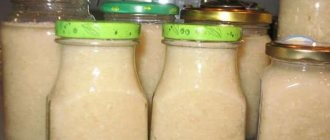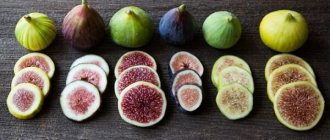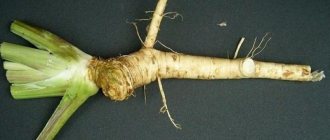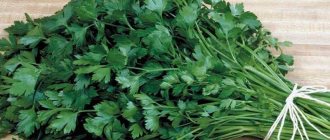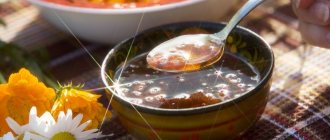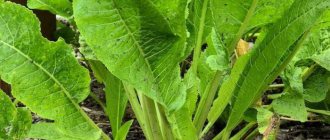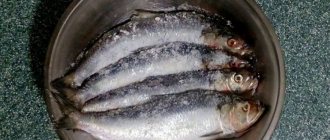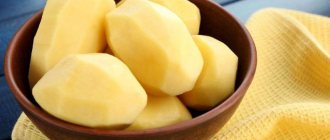Nature is very generous, not only with people, but also with plants, which have much greater properties than are known to mankind. But science does not stand still, so every year people learn more and more about plants.
For example, the same horseradish root in ancient times was used only as a seasoning, but now it can cure many diseases. And, besides, horseradish has not only a pungent taste, but also a number of unique properties, which became known thanks to scientists.
What is good about dry horseradish?
Dried horseradish is almost as good as fresh horseradish in terms of nutritional content and taste, takes up little space in the kitchen cabinet and is stored for a long time.
Properties, nutritional value
The calorie content of horseradish is low - 56 kcal per 100 g. Energy value:
- proteins - 3.2 g;
- fats - 0.4 g;
- carbohydrates - 10.5 g.
Horseradish root is rich in vitamins and minerals:
- vitamin C - strengthens the immune system and blood vessels, participates in the synthesis of collagen and serotonin;
- B vitamins - support the functioning of the nervous system, participate in metabolic processes;
- silicon - important for strong bones, healthy teeth and beautiful nails;
- potassium - regulates water and acid balances, important for the conduction of nerve impulses;
- calcium - normalizes the functioning of the nervous system, strengthens bones, and participates in muscle contraction.
The roots contain a lot of magnesium, sodium, sulfur, phosphorus, iron, manganese, molybdenum, and zinc. Omega-3 and 6 fatty acids strengthen the cardiovascular system, reduce inflammatory reactions, and normalize blood cholesterol levels.
Essential mustard oils give horseradish a specific “burning” taste and smell and improve digestion.
Reference! The leaves contain up to 0.35% vitamin C, carotene and alkaloids.
Horseradish has antibacterial properties, as it contains phytoncides that destroy pathogenic microorganisms, protecting the body from infectious diseases.
The enzyme peroxidase promotes the breakdown of cancer cells, which is important for the prevention of malignant tumors.
The roots and leaves of the plant have beneficial properties, but in different proportions, which determines their use in certain cases.
Advantages and disadvantages of this harvesting method
By drying and then grinding horseradish roots, a concentrated product is obtained in powder form.
Pros:
- most of the beneficial properties and aroma are preserved;
- does not require a lot of space or special storage conditions;
- long shelf life (up to 2 years).
However, during processing, some essential oils and phytoncides evaporate. As a result, the “hotness” of horseradish decreases, the smell becomes less pungent, and the medicinal properties are reduced.
Drying takes more time and money (increasing gas or electricity costs).
Why is it so difficult to grate horseradish root?
It is much more difficult to grate horseradish without tears than onions. Irritated red eyes, salty streams running down my face, and even a swirl in my nose. Such unpleasant side effects can discourage any desire to independently prepare dishes from this useful plant. The fact is that it contains essential oils, which, when the root is crushed, quickly enter the air, making it burning and irritating to the mucous membranes. This is why it is so difficult to grate it by hand, especially in large quantities. In addition, the roots must be washed from dirt and cleaned.
Peeling horseradish is much easier than grating it, if only for the reason that less burning substances are released. To make cleaning easier, it is advisable to pre-soak the roots in cold water for 5-6 hours. It is best to wash under the tap using a brush or kitchen sponge. Remove the peel using a sharp knife, vegetable peeler or steel wool.
Turning horseradish root into fine shavings is not an easy task.
Selection and preparation of horseradish for drying
Both horseradish leaves and its roots are dried. Leaves are harvested in the summer, selecting green, juicy specimens without pests. Thick petioles are cut out of them. If the leaves are very dirty, they are washed under cold water and dried thoroughly.
The roots are collected in the fall, in October-November, in dry weather. Carefully dig up the rhizomes and cut off the old foliage.
Important! The roots should have a solid structure and a rich smell. Sluggish specimens with deep cracks, damage, and stains indicate old roots or improper storage (if purchased). It is better not to use such rhizomes, since most of the beneficial substances in them have already disappeared.
Rotten or damaged roots are thrown away. The rest are cleared of soil, small shoots and damaged parts are cut off, everything is quickly washed with cold water so that the roots do not have time to become saturated with excess moisture, and the top layer of skin is thinly cut off. The roots are slightly dried and ventilated in fresh air away from sunlight.
The caustic volatile compounds that horseradish produces can cause skin and eye irritation, so it is recommended that you wear protective gloves, goggles, and a mask when cleaning and chopping.
Why is it so difficult to grate horseradish root?
It is much more difficult to grate horseradish without tears than onions. Irritated red eyes, salty streams running down my face, and even a swirl in my nose. Such unpleasant side effects can discourage any desire to independently prepare dishes from this useful plant. The fact is that it contains essential oils, which, when the root is crushed, quickly enter the air, making it burning and irritating to the mucous membranes. This is why it is so difficult to grate it by hand, especially in large quantities. In addition, the roots must be washed from dirt and cleaned.
Peeling horseradish is much easier than grating it, if only for the reason that less burning substances are released. To make cleaning easier, it is advisable to pre-soak the roots in cold water for 5-6 hours. It is best to wash under the tap using a brush or kitchen sponge. Remove the peel using a sharp knife, vegetable peeler or steel wool.
Turning horseradish root into fine shavings is not an easy task.
How to dry horseradish correctly
It is better to dry the leaves outdoors, in the shade, and for the roots there are several ways to prepare them. The choice depends on the drying location and the availability of kitchen appliances.
On air
To do this, use a slightly darkened room with low air humidity (no more than 50%), where direct sunlight does not penetrate and where regular ventilation is possible.
Suitable for this:
- shed or shed;
- balcony, loggia, veranda;
- a separate room in a house or apartment (this is an extreme option, since the sharp aroma of horseradish will spread throughout the room, which will permeate all the clothes).
Using a sharp knife, cut the roots into thin circles, strips or small cubes, and lightly chop the leaves. Lay everything out on clean sheets of paper and leave it in the chosen place for 8–10 days.
Attention! When drying leaves, the ambient temperature should not be higher than +40°C to preserve the essential oils.
Procurement time depends on:
- temperature and humidity in the room (the lower the first and higher the second, the longer the horseradish will dry);
- the size and thickness of the cut slices of root or leaves (the smaller and thinner they are, the faster they dry);
- availability of ventilation and proper air circulation in the room.
To ensure uniform evaporation of moisture, the product is periodically turned over. Thin roots are not cut, but tied together so that air can circulate freely between them, and in this form they are hung to dry. The same is done with small leaves, having first strung them on a strong thread.
In the oven
For drying in the oven, set the temperature to +40...+45˚C. Place the prepared plant roots (peeled, washed and thinly sliced) on a wide baking sheet covered with parchment paper. Dry the plant for about 2 hours.
To prevent the horseradish from being baked and dried, the oven door should be half open. After this, the device is turned off for 1 hour, but the roots are not removed, but dried for another 2 hours. In 2-3 approaches, the roots will dry to perfect condition.
Preliminary grinding of the roots will reduce the drying time by about 2 times. To do this, use a food processor, meat grinder, juicer or blender. The power of the device must be at least 700 W, otherwise it will not cope with the solid structure of the plant.
In an electric dryer
Using an electric dryer speeds up the workpiece by circulating hot air. The pieces will not brown, as can happen in the oven. The working and resting times of the device alternate:
- The chopped horseradish is placed on baking sheets without covering the openings for the movement of hot air.
- Close the dryer.
- Set the temperature to +40…+45˚C.
- After 2–2.5 hours the device is turned off.
- Rearrange the baking sheets: the bottom ones are up, and the top ones are down (this will allow drying to take place more evenly).
- Close the electric dryer and leave for 1.5 hours.
- Turn it on again at the same temperature for 2–2.5 hours.
Repeat the steps until the desired result is obtained.
Grinding methods at home, their pros and cons
Inventive cooks come up with everything they can to minimize the discomfort when grinding this sharp, burning root. They put on a diving mask, goggles, and even a gas mask. The whole process of grinding horseradish turns into a comedy performance to the delight of those present in the house. But there are less fun ways to turn the stinging root into pulp without tears or sobs. Let's look at each of them.
Delicious recipe! Hot brunettes with blue eyes
Grating with a food bag
This is probably one of the oldest methods. Modern housewives practically don’t use it anymore due to its labor-intensive and time-consuming nature compared to other methods. If you don’t have any suitable tools in the kitchen other than a grater, then you will also need a regular food bag for storing food. Of course, it should be transparent, clean and quite spacious.
- Pre-wash and clean the roots in any convenient way.
- Place the grater and peeled horseradish in a bag.
- Tie the bag tightly.
- Grasp the root on top of the bag with your right hand and hold the grater with your left (or vice versa if you're left-handed).
- Grate the root, being careful not to damage the bag.
- When the job is done, untie the bag.
- Transfer the resulting slurry to the desired container.
- Horseradish is ready for further processing.
Horseradish, finely grated, is suitable for making pasta and sauce
Do not use bags not intended for food storage. The ideal option is a spacious transparent cellophane bag, in which vegetables or bread are usually placed.
The disadvantage of this method is that it is quite difficult to grate a large amount of horseradish. Moreover, doing this in a package is not very convenient. The advantage is that substances that irritate the mucous membranes remain in the bag and the grinding process takes place practically without tears.
It is better to use a grater only if you need to grate a small piece of horseradish
Freezing and grinding in a meat grinder
It is much easier to grind horseradish in a meat grinder. To prevent it from eating your eyes out during grinding, it must first be frozen. When frozen, it does not lose its beneficial properties, it becomes soft and less pungent.
Before putting the peeled roots in the freezer, it is advisable to immediately cut them into small pieces. Then they are taken out, defrosted and started chopping. How to do:
- Wash and clean the horseradish.
- Cut into pieces 3–4 cm long.
- Place in a plastic bag and place in the freezer for 4-5 hours
The peeled roots are placed in a bag and sent to the freezer.
Using a meat grinder will not grind the root into pulp.
The big advantage of this method is that after defrosting the root becomes softer and much easier to twist. This is doubly good if you have an old Soviet meat grinder and have to work with your hands. The downside of this method is that twisting a large amount of horseradish by hand is not as easy as it seems. In addition, you first need to freeze the root, then defrost it, etc.
Twisting in a meat grinder + bag
If you are the happy owner of a modern electric meat grinder, then grinding horseradish will not be difficult at all. In addition to the miracle device, you will also need a spacious food bag. It is he who will save you from the pungent aroma and tears. The bag is placed over the opening of the meat grinder, from which the ground mass comes out. The ends are tied tightly or secured with an elastic band.
Since peeled horseradish tends to darken when exposed to air, we recommend placing it in a deep bowl and pouring cold water over it.
To prevent the peeled root from darkening, it is poured with cold water.
- Cut the pre-washed and peeled horseradish into pieces.
To make the root easier to grind in a meat grinder, it needs to be chopped into small pieces
The bag must be tied tightly so that it does not slip off when twisting.
Due to the fact that the ground particles immediately fall into the bag, there is no unpleasant sensation
It is better not to store crushed horseradish for longer than 15 hours - it begins to lose its beneficial properties
As you can see, with the help of a modern electric meat grinder and a little trick, you can really grind horseradish easily and, importantly, without tears. In this way, you can use a regular manual meat grinder.
To make this method even easier, place the bowl directly into the bag. The crushed pieces will fall directly into the container.
With this trick, the chopped horseradish root immediately falls into the bowl
Another way to twist
There is a very interesting know-how on grinding horseradish. You will need a modern electric meat grinder, a narrow plastic bag without handles, a half-liter glass jar and two rubber bands. There is no need to freeze the root, just cut it into small pieces. Do the following:
- Cut the welded end of the bag to create a “sleeve”.
- Place one end of the “sleeve” over the neck of the jar and secure with an elastic band.
- Move the jar closer to the outlet of the meat grinder.
- Place the free end of the “sleeve” over the outlet hole and also secure with an elastic band.
- Turn on the electrical appliance and twist the horseradish.
Using this simple method, the chopped root goes directly into the jar. You don’t suffer or cry at all, but just quickly pour the chopped root into the meat grinder and enjoy the process. This method is good if you need to twist a large amount of horseradish, and requires virtually no effort on your part.
Video: how to quickly grind horseradish in a meat grinder without tears
Easy grinding in a blender
You will need a stand blender with a glass or plastic blending bowl. Pay attention to its power - devices with a power of less than 700 W are unlikely to cope with this task.
Important: do not fill the bowl to the very top, tightly stuffing it with pieces of horseradish. The device will not completely chop the roots and may even break. It is also useless to throw in a few pieces and turn on the blender - it will not grind them.
So, you have a good stand-up blender and some horseradish roots that need processing. In this case, it is important to completely cut off the hard skin when cleaning - it will be easier to chop and you will get a uniform consistency. You will also need a cutting board and a knife, since the peeled roots need to be cut into circles. If the root is large, it is better to cut it lengthwise into two parts and then cut into pieces.
Using a powerful blender, you can quickly chop horseradish without spilling even a tear.
Since horseradish root itself is dry and hard, it is quite difficult to chop it. To make his work easier, we recommend adding a little water.
- Wash and clean the roots.
- Cut into circles, 0.5 cm thick.
- Place the chopped horseradish in the chopper bowl.
The sharp blades of the chopper will finely chop the root
The blender will grind the horseradish efficiently, significantly saving your effort and time.
You don’t have to pour water right away. Look at the situation and how the chopper copes. If the motor turns easily, do not add water.
To grind horseradish faster and more efficiently, you should add a little water to the bowl.
A huge advantage of this method is that even small roots are suitable for processing. There are practically no disadvantages. But if you decide to add water, then keep in mind that the crushed mass will be a little liquid and is not suitable for every dish.
You can also use a regular immersion blender, in which the chopper is attached to a handle with a motor.
Grinding in a food processor or juicer: how to do it correctly
Probably the easiest and fastest way. A food processor will easily cope with this task. The big advantage is that it is not necessary to first cut the root into small pieces. This will save significant time.
So, you will need a nozzle with small holes. Instructions:
- Wash and clean the roots.
- Turn on the combine.
- Place the peeled root in a special receptacle and press on it.
- Push with a special pusher.
- Continue in this manner until everything is chopped.
- Turn off the combine.
- Place the chopped horseradish into a bowl.
You can use a food processor to chop large quantities of horseradish.
As you can see, everything is very simple, quick and without tears.
If you don't have a food processor, but have a powerful juicer for hard fruits and vegetables, feel free to use it. The roots can be cut into pieces or left as is. As in the case of fruits and vegetables, you will get juice and cake separately. Once you have chopped all the horseradish, simply mix everything together in a bowl until you get a uniform consistency. The big advantage of this method is that the horseradish is ground very finely, literally into a pulp. No deficiencies found.
Preparation of dry seasoning in powder form: recipe
Horseradish is also prepared in dry form. Most often, the dried roots are ground into powder and used to make hot sauces. Dry in a conventional oven at a temperature of 50–60 °C or in a special electric dryer for fruits and vegetables. Grind into flour using a manual or electric coffee grinder or blender. You can also crush it in a mortar.
- Wash and clean the roots.
- Cut into thin slices.
Thinly chopped roots are suitable for drying.
To help moisture escape faster, you can place a wooden stick between the door and the oven itself.
Delicious recipe! How to close honey mushrooms in jars recipe
After drying, horseradish slices become brittle and easily grind
Dried horseradish flour can be stored for 2 years
You can first crush the horseradish in a mortar and then grind it in a blender or coffee grinder. This seasoning is stored in tightly closed glass jars all winter and used as needed. Before you start cooking, the powder is diluted in water to the desired consistency.
In order to obtain fine flour without pieces, we recommend sifting the resulting powder through a sieve. If there are a lot of solid pieces, grind them again or grind them in a mortar.
You can also dry the root, grated on a coarse grater or in a food processor using an attachment with larger holes. Then the drying process will be reduced by at least half.
Video: how to prepare horseradish powder
Where and how to use the spice
For lovers of spicy food, horseradish takes pride of place. Not a single holiday table is complete without it. The plant strengthens the immune system, reduces inflammation, and destroys pathogenic microorganisms, so it is regularly consumed in small quantities and is actively used for medicinal purposes.
Use in cooking
The dried root is used in the preparation of various seasonings, marinades and sauces. To do this, pour the powder with warm boiled water or other liquid and leave until it swells for about 30 minutes. Then the remaining ingredients are added.
Crushed leaves are used mainly for canning vegetables: they enrich the taste of pickled, pickled and salted foods, preventing the formation of mold.
The unique aroma of the root is well revealed when cooking meat or fish. The use of horseradish in the preparation of kvass makes it “vigorous” and an excellent thirst quencher, and the strong horseradish tincture strengthens the fortitude and warms in small doses.
In folk medicine
Horseradish is a powerful natural antibiotic with an expectorant effect. It is used for colds, used in the form of decoctions, for inhalation, rinsing the mouth and throat.
Compresses made from root pulp reduce pain in the joints and lower back. Horseradish tincture has strong wound healing properties.
Horseradish quickly restores strength in case of overwork and vitamin deficiency. For diabetics it will help normalize blood sugar levels. Thanks to its diuretic effect, it helps cleanse the kidneys.
Regular consumption of horseradish improves male potency by normalizing blood circulation.
Face masks containing horseradish help get rid of acne. The active components of a natural antiseptic cleanse the skin and dry it, destroying bacteria.
The product is not recommended for use:
- in the presence of gastritis, ulcers and increased acidity of gastric juice;
- with kidney inflammation;
- for skin diseases;
- pregnant and lactating women.
Grinding methods at home, their pros and cons
Inventive cooks come up with everything they can to minimize the discomfort when grinding this sharp, burning root. They put on a diving mask, goggles, and even a gas mask. The whole process of grinding horseradish turns into a comedy performance to the delight of those present in the house. But there are less fun ways to turn the stinging root into pulp without tears or sobs. Let's look at each of them.
Grating with a food bag
This is probably one of the oldest methods. Modern housewives practically don’t use it anymore due to its labor-intensive and time-consuming nature compared to other methods. If you don’t have any suitable tools in the kitchen other than a grater, then you will also need a regular food bag for storing food. Of course, it should be transparent, clean and quite spacious.
- Pre-wash and clean the roots in any convenient way.
- Place the grater and peeled horseradish in a bag.
- Tie the bag tightly.
- Grasp the root on top of the bag with your right hand and hold the grater with your left (or vice versa if you're left-handed).
- Grate the root, being careful not to damage the bag.
- When the job is done, untie the bag.
- Transfer the resulting slurry to the desired container.
- Horseradish is ready for further processing.
Horseradish, finely grated, is suitable for making pasta and sauce
Do not use bags not intended for food storage. The ideal option is a spacious transparent cellophane bag, in which vegetables or bread are usually placed.
The disadvantage of this method is that it is quite difficult to grate a large amount of horseradish. Moreover, doing this in a package is not very convenient. The advantage is that substances that irritate the mucous membranes remain in the bag and the grinding process takes place practically without tears.
It is better to use a grater only if you need to grate a small piece of horseradish
Freezing and grinding in a meat grinder
It is much easier to grind horseradish in a meat grinder. To prevent it from eating your eyes out during grinding, it must first be frozen. When frozen, it does not lose its beneficial properties, it becomes soft and less pungent.
Before putting the peeled roots in the freezer, it is advisable to immediately cut them into small pieces. Then they are taken out, defrosted and started chopping. How to do:
- Wash and clean the horseradish.
- Cut into pieces 3–4 cm long.
- Place in a plastic bag and place in the freezer for 4-5 hours
The peeled roots are placed in a bag and sent to the freezer.
Using a meat grinder will not grind the root into pulp.
The big advantage of this method is that after defrosting the root becomes softer and much easier to twist. This is doubly good if you have an old Soviet meat grinder and have to work with your hands. The downside of this method is that twisting a large amount of horseradish by hand is not as easy as it seems. In addition, you first need to freeze the root, then defrost it, etc.
Twisting in a meat grinder + bag
If you are the happy owner of a modern electric meat grinder, then grinding horseradish will not be difficult at all. In addition to the miracle device, you will also need a spacious food bag. It is he who will save you from the pungent aroma and tears. The bag is placed over the opening of the meat grinder, from which the ground mass comes out. The ends are tied tightly or secured with an elastic band.
Since peeled horseradish tends to darken when exposed to air, we recommend placing it in a deep bowl and pouring cold water over it.
To prevent the peeled root from darkening, it is poured with cold water.
Delicious recipe! Useful herbs for immunity
- Cut the pre-washed and peeled horseradish into pieces.
To make the root easier to grind in a meat grinder, it needs to be chopped into small pieces
The bag must be tied tightly so that it does not slip off when twisting.
Due to the fact that the ground particles immediately fall into the bag, there is no unpleasant sensation
It is better not to store crushed horseradish for longer than 15 hours - it begins to lose its beneficial properties
As you can see, with the help of a modern electric meat grinder and a little trick, you can really grind horseradish easily and, importantly, without tears. In this way, you can use a regular manual meat grinder.
To make this method even easier, place the bowl directly into the bag. The crushed pieces will fall directly into the container.
With this trick, the chopped horseradish root immediately falls into the bowl
Another way to twist
There is a very interesting know-how on grinding horseradish. You will need a modern electric meat grinder, a narrow plastic bag without handles, a half-liter glass jar and two rubber bands. There is no need to freeze the root, just cut it into small pieces. Do the following:
- Cut the welded end of the bag to create a “sleeve”.
- Place one end of the “sleeve” over the neck of the jar and secure with an elastic band.
- Move the jar closer to the outlet of the meat grinder.
- Place the free end of the “sleeve” over the outlet hole and also secure with an elastic band.
- Turn on the electrical appliance and twist the horseradish.
Using this simple method, the chopped root goes directly into the jar. You don’t suffer or cry at all, but just quickly pour the chopped root into the meat grinder and enjoy the process. This method is good if you need to twist a large amount of horseradish, and requires virtually no effort on your part.
Video: how to quickly grind horseradish in a meat grinder without tears
Easy grinding in a blender
You will need a stand blender with a glass or plastic blending bowl. Pay attention to its power - devices with a power of less than 700 W are unlikely to cope with this task.
Important: do not fill the bowl to the very top, tightly stuffing it with pieces of horseradish. The device will not completely chop the roots and may even break. It is also useless to throw in a few pieces and turn on the blender - it will not grind them.
So, you have a good stand-up blender and some horseradish roots that need processing. In this case, it is important to completely cut off the hard skin when cleaning - it will be easier to chop and you will get a uniform consistency. You will also need a cutting board and a knife, since the peeled roots need to be cut into circles. If the root is large, it is better to cut it lengthwise into two parts and then cut into pieces.
Using a powerful blender, you can quickly chop horseradish without spilling even a tear.
Since horseradish root itself is dry and hard, it is quite difficult to chop it. To make his work easier, we recommend adding a little water.
- Wash and clean the roots.
- Cut into circles, 0.5 cm thick.
- Place the chopped horseradish in the chopper bowl.
The sharp blades of the chopper will finely chop the root
The blender will grind the horseradish efficiently, significantly saving your effort and time.
You don’t have to pour water right away. Look at the situation and how the chopper copes. If the motor turns easily, do not add water.
To grind horseradish faster and more efficiently, you should add a little water to the bowl.
A huge advantage of this method is that even small roots are suitable for processing. There are practically no disadvantages. But if you decide to add water, then keep in mind that the crushed mass will be a little liquid and is not suitable for every dish.
You can also use a regular immersion blender, in which the chopper is attached to a handle with a motor.
Grinding in a food processor or juicer: how to do it correctly
Probably the easiest and fastest way. A food processor will easily cope with this task. The big advantage is that it is not necessary to first cut the root into small pieces. This will save significant time.
So, you will need a nozzle with small holes. Instructions:
- Wash and clean the roots.
- Turn on the combine.
- Place the peeled root in a special receptacle and press on it.
- Push with a special pusher.
- Continue in this manner until everything is chopped.
- Turn off the combine.
- Place the chopped horseradish into a bowl.
You can use a food processor to chop large quantities of horseradish.
As you can see, everything is very simple, quick and without tears.
If you don't have a food processor, but have a powerful juicer for hard fruits and vegetables, feel free to use it. The roots can be cut into pieces or left as is. As in the case of fruits and vegetables, you will get juice and cake separately. Once you have chopped all the horseradish, simply mix everything together in a bowl until you get a uniform consistency. The big advantage of this method is that the horseradish is ground very finely, literally into a pulp. No deficiencies found.
Preparation of dry seasoning in powder form: recipe
Horseradish is also prepared in dry form. Most often, the dried roots are ground into powder and used to make hot sauces. Dry in a conventional oven at a temperature of 50–60 °C or in a special electric dryer for fruits and vegetables. Grind into flour using a manual or electric coffee grinder or blender. You can also crush it in a mortar.
- Wash and clean the roots.
- Cut into thin slices.
Thinly chopped roots are suitable for drying.
To help moisture escape faster, you can place a wooden stick between the door and the oven itself.
After drying, horseradish slices become brittle and easily grind
Dried horseradish flour can be stored for 2 years
You can first crush the horseradish in a mortar and then grind it in a blender or coffee grinder. This seasoning is stored in tightly closed glass jars all winter and used as needed. Before you start cooking, the powder is diluted in water to the desired consistency.
In order to obtain fine flour without pieces, we recommend sifting the resulting powder through a sieve. If there are a lot of solid pieces, grind them again or grind them in a mortar.
You can also dry the root, grated on a coarse grater or in a food processor using an attachment with larger holes. Then the drying process will be reduced by at least half.
